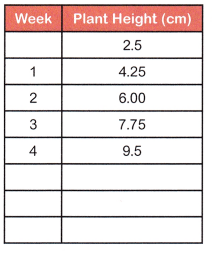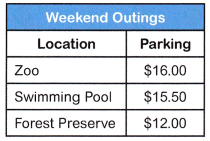All the solutions provided in McGraw Hill Math Grade 5 Answer Key PDF Chapter 6 Test are as per the latest syllabus guidelines.
McGraw-Hill Math Grade 5 Chapter 6 Test Answer Key
Identify the least common multiple, LCM, for each pair of numbers.
Question 1.
5, 6 __________
Answer:
LCM of 5, 6 is 30.
Explanation:
Here, multiplies of 5 are 5, 10, 15, 20, 25, and 30.
Multiples of 6 are 6, 12, 18, 24, and 30.
So LCM of 5, 6 is 30.
Question 2.
7, 8 _____
Answer:
LCM of 7, 8 is 56.
Explanation:
Here, multiplies of 7 are 7, 14, 21, 28, 35, 42, 49, and 56.
Multiples of 8 are 8, 16, 24, 32, 40, 48 and 56.
So LCM of 7, 8 is 56.
Question 3.
3, 4 ________
Answer:
LCM of 3, 4 is 12.
Explanation:
Here, multiplies of 3 are 3, 6, 9, and 12.
Multiples of 4 are 4, 8, 12.
So LCM of 3, 4 is 12.
Question 4.
7, 6 _________
Answer:
LCM of 7, 6 is 42.
Explanation:
Here, multiplies of 7, 14, 21, 28, 35, and 42,
Multiples of 6 are 6, 12, 18, 24, 30, 36, and 42.
So LCM of 7, 6 is 42.
Question 5.
10, 12 ____
Answer:
LCM of 10, 12 is 120.
Explanation:
Here, multiplies of 10 are 10, 20, 30, 40, 50, 60, 70, 80, 90, 100, 110, and120.
Multiples of 12 are 12, 24, 36, 48, 60, 72, 84, 96, 108, and 120.
So LCM of 10, 12 is 120.
Question 6.
6, 9 _________
Answer:
LCM of 6, 9 is 54.
Explanation:
Here, multiplies of 6 are 6, 12, 18, 24, 30, 36, 42, 48, and 54.
Multiples of 9 are 9, 18, 27, 36, 45, 54.
So LCM of 6, 9 is 54.
Question 7.
2, 5 _________
Answer:
LCM of 2, 5 is 10.
Explanation:
Here, multiplies of 2 are 2, 4, 6, 8 and 10 .
Multiples of 5 are 5, and 10.
So LCM of 2, 5 is 10.
Question 8.
5, 3 ________
Answer:
LCM of 3, 4 is 12.
Explanation:
Here, multiplies of 5 are 5, 10, and 15.
Multiples of 3 are 3, 6, 9, 12 and 15.
So LCM of 3, 4 is 12.
Find the equivalent fractions.
Question 9.
equivalent to \(\frac{1}{2}\), denominator 22 ___________
Answer:
The equivalent fraction is \(\frac{11}{22}\).
Explanation:
The equivalent fraction to \(\frac{1}{2}\) with denominator 22 is \(\frac{1}{2}\) × \(\frac{11}{11}\) = \(\frac{11}{22}\).
Question 10.
equivalent to \(\frac{2}{5}\), denominator 20 _________
Answer:
The equivalent fraction is \(\frac{8}{20}\).
Explanation:
The equivalent fraction to \(\frac{2}{5}\) with denominator 20 is \(\frac{2}{5}\) × \(\frac{4}{4}\) = \(\frac{8}{20}\).
Question 11.
equivalent to \(\frac{3}{7}\), denominator 35 _________
Answer:
The equivalent fraction is \(\frac{15}{35}\).
Explanation:
The equivalent fraction to \(\frac{3}{7}\) with denominator 35 is \(\frac{3}{7}\) × \(\frac{5}{5}\) = \(\frac{15}{35}\).
Question 12.
equivalent to \(\frac{2}{3}\), denominator 12 _________
Answer:
The equivalent fraction is \(\frac{8}{12}\).
Explanation:
The equivalent fraction to \(\frac{2}{3}\) with denominator 12 is \(\frac{2}{3}\) × \(\frac{4}{4}\) = \(\frac{8}{12}\).
Question 13.
equivalent to \(\frac{3}{5}\), denominator 15 _________
Answer:
The equivalent fraction is \(\frac{9}{15}\).
Explanation:
The equivalent fraction to \(\frac{3}{5}\) with denominator 15 is \(\frac{3}{5}\) × \(\frac{3}{3}\) = \(\frac{9}{15}\).
Question 14.
equivalent to \(\frac{1}{3}\), denominator 21 _________
Answer:
The equivalent fraction is \(\frac{7}{21}\).
Explanation:
The equivalent fraction to \(\frac{1}{3}\) with denominator 21 is \(\frac{1}{3}\) × \(\frac{7}{7}\) = \(\frac{7}{21}\).
Add or subtract. Give answers in simplest terms.
Question 15.
\(\frac{1}{4}\) + \(\frac{1}{4}\) ___________
Answer:
\(\frac{1}{4}\) + \(\frac{1}{4}\) = \(\frac{1}{2}\).
Explanation:
The simplest form of \(\frac{1}{4}\) + \(\frac{1}{4}\) which is \(\frac{1+1}{4}\)
= \(\frac{2}{4}\)
= \(\frac{1}{2}\).
Question 16.
\(\frac{2}{9}\) + \(\frac{5}{9}\) ___________
Answer:
\(\frac{2}{9}\) + \(\frac{5}{9}\) = \(\frac{7}{9}\).
Explanation:
The simplest form of \(\frac{2}{9}\) + \(\frac{5}{9}\) which is \(\frac{5+2}{9}\)
= \(\frac{7}{9}\).
Question 17.
\(\frac{3}{7}\) – \(\frac{2}{7}\) ___________
Answer:
\(\frac{3}{7}\) – \(\frac{2}{7}\) = \(\frac{1}{7}\).
Explanation:
The simplest form of \(\frac{3}{7}\) – \(\frac{2}{7}\) which is \(\frac{3 – 2}{7}\)
= \(\frac{1}{7}\).
Question 18.
\(\frac{3}{3}\) + \(\frac{2}{5}\) ___________
Answer:
\(\frac{3}{3}\) + \(\frac{2}{5}\) = 1\(\frac{2}{5}\).
Explanation:
The simplest form of \(\frac{3}{3}\) + \(\frac{2}{5}\) which is \(\frac{15+6}{15}\)
= \(\frac{21}{15}\)
= \(\frac{7}{5}\)
= 1\(\frac{2}{5}\).
Question 19.
\(\frac{9}{17}\) – \(\frac{5}{17}\) ___________
Answer:
\(\frac{9}{17}\) – \(\frac{5}{17}\) = \(\frac{4}{17}\).
Explanation:
The simplest form of \(\frac{9}{17}\) – \(\frac{5}{17}\) which is \(\frac{9-5}{17}\)
= \(\frac{4}{17}\).
Question 20.
\(\frac{5}{8}\) – \(\frac{3}{8}\) ___________
Answer:
\(\frac{5}{8}\) – \(\frac{3}{8}\) = \(\frac{1}{4}\).
Explanation:
The simplest form of \(\frac{5}{8}\) – \(\frac{3}{8}\) which is \(\frac{5-3}{8}\)
= \(\frac{2}{8}\)
= \(\frac{1}{4}\).
Add or subtract. Give answers in simplest terms.
Question 21.

Answer:
\(\frac{1}{7}\) – \(\frac{1}{8}\) = \(\frac{1}{56}\).
Explanation:
The simplest form of \(\frac{1}{7}\) – \(\frac{1}{8}\) which is \(\frac{8-7}{56}\)
= \(\frac{1}{56}\).
Question 22.

Answer:
1\(\frac{1}{2}\) + 1\(\frac{3}{7}\) = 2\(\frac{13}{14}\).
Explanation:
The simplest form of 1\(\frac{1}{2}\) + 1\(\frac{3}{7}\) which is \(\frac{3}{2}\) + \(\frac{10}{7}\)
= \(\frac{21+20}{14}\)
= \(\frac{41}{14}\)
= 2\(\frac{13}{14}\).
Question 23.

Answer:
3\(\frac{2}{3}\) + 2\(\frac{3}{5}\) = 6\(\frac{4}{15}\).
Explanation:
The simplest form of 3\(\frac{2}{3}\) + 2\(\frac{3}{5}\) which is \(\frac{11}{3}\) + \(\frac{13}{5}\)
= \(\frac{55+39}{15}\)
= \(\frac{94}{15}\)
= 6\(\frac{4}{15}\).
Question 24.

Answer:
5\(\frac{1}{6}\) – 4\(\frac{1}{7}\) =
Explanation:
The simplest form of 5\(\frac{1}{6}\) – 4\(\frac{1}{7}\) which is \(\frac{31}{6}\) – \(\frac{29}{7}\)
= \(\frac{217-174}{42}\)
= \(\frac{43}{42}\)
= 1\(\frac{1}{42}\).
Question 25.

Answer:
1\(\frac{1}{2}\) + 1\(\frac{2}{3}\) = 3\(\frac{1}{6}\).
Explanation:
The simplest form of 1\(\frac{1}{2}\) + 1\(\frac{2}{3}\) which is \(\frac{3}{2}\) + \(\frac{5}{3}\)
= \(\frac{9+10}{6}\)
= \(\frac{19}{6}\)
= 3\(\frac{1}{6}\).
Question 26.

Answer:
3\(\frac{2}{5}\) – 2\(\frac{1}{4}\) = 1\(\frac{3}{20}\).
Explanation:
The simplest form of 3\(\frac{2}{5}\) – 2\(\frac{1}{4}\) which is \(\frac{17}{5}\) – \(\frac{9}{4}\)
= \(\frac{68-45}{20}\)
= \(\frac{23}{20}\)
= 1\(\frac{3}{20}\).
Question 27.

Answer:
8\(\frac{1}{7}\) – 7\(\frac{1}{8}\) = 1\(\frac{1}{56}\).
Explanation:
The simplest form of 8\(\frac{1}{7}\) – 7\(\frac{1}{8}\) which is \(\frac{57}{7}\) – \(\frac{57}{8}\)
= \(\frac{456-399}{56}\)
= \(\frac{57}{56}\)
= 1\(\frac{1}{56}\).
Question 28.

Answer:
5\(\frac{1}{6}\) + 4\(\frac{1}{7}\) = 9\(\frac{13}{42}\).
Explanation:
The simplest form of 5\(\frac{1}{6}\) + 4\(\frac{1}{7}\) which is \(\frac{31}{6}\) + \(\frac{29}{7}\)
= \(\frac{217+174}{42}\)
= \(\frac{391}{42}\)
= 9\(\frac{13}{42}\).
Solve.
Question 29.
Randy built a pool that is 30 feet x 20 feet. Then he built a wooden deck that is 6 feet wide around all four sides of the pool. What is the area of the deck? Draw a diagram to help you find the answer.
Answer:
Question 30.
Phillip walks 4\(\frac{1}{2}\) blocks to school. Joyce walks 3\(\frac{3}{4}\) blocks to the same school. How much farther does Phillip walk than Joyce?
Answer:
Question 31.

What subtraction problem is represented on this number line?
Answer:
Question 32.
George recorded the height of his bean plant every week for Week Plant Height (cm) four weeks. If the same pattern continues, how tall will his plant be in the seventh week?
_____________________________________________________

Answer:
For the seventh week, it will be 14.75 cm.
Explanation:
Given that George recorded the height of his bean plant every week for Week Plant Height (cm) for four weeks. Here, the pattern follows adding 1.75 to the next digit. So for the 5th week, it will be 9.5+1.75 = 11.25
6th week it will be 11.25+1.75 = 13 and for the seventh week, it will be 13+1.75 = 14.75.
Question 33.
Cammie works a total of 25 hours on Friday, Saturday, and Sunday. She works 7 hours on Saturday. She works twice as many hours on Sunday as she does on Friday. How many hours does Cammie work on Sunday?
Answer:
Question 34.
The Romero, Hill. and Johnson families each went on a weekend outing. The Romero’s parking was not the most expensive. The Hill’s parking cost less than the Romero’s. Which location did each family visit?

Answer:
Romero’s parking is near the swimming pool,
Hill’s parking is near a forest preserve, and Johnson families parking is near the zoo.
Explanation:
Given that the Romero, Hill. and Johnson families each went on a weekend outing and the Romero’s parking was not the most expensive and Hill’s parking cost less than Romero’s. So Romero’s parking is near the swimming pool which costs $15.50 and Hill’s parking is near a forest preserve which is $12.00 and Johnson families parking is near the zoo which costs $16.00.